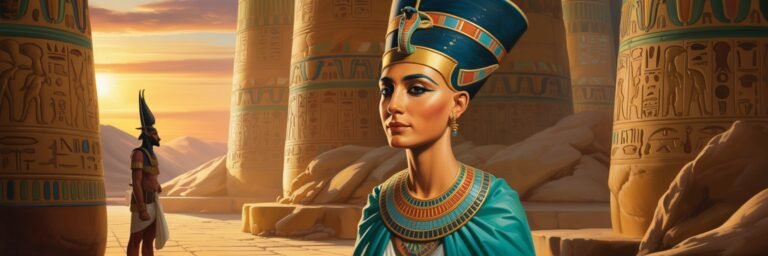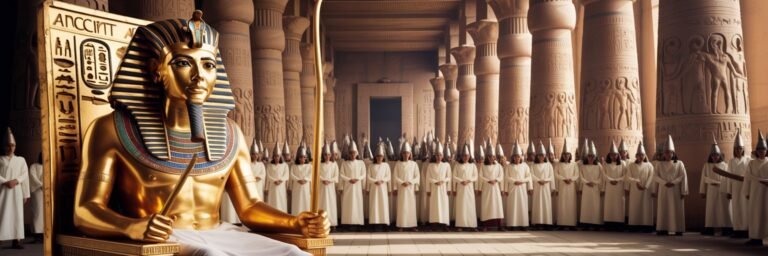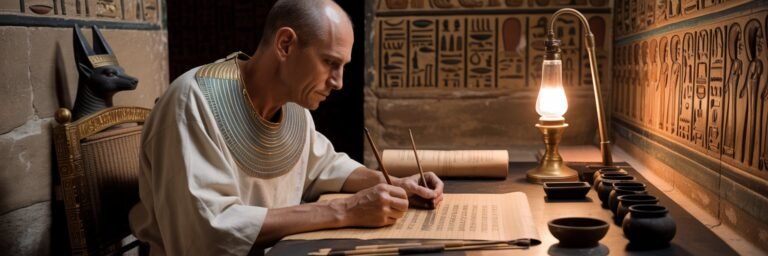INTRODUCTION
Since time immemorial, the world has been enthralled by Ancient Egypt— a civilization whose rich, enigmatic tapestry blends historical reality with enduring myth that encounters the boundary between magic and science. With pyramids that parallel the stars, gods who ruled over earth and the heavens, and hieroglyphs that whispered tales from ages old— Ancient Egypt presents an enigma that perennially entices historians, archaeologists, and enthusiasts. This article strives to document and decode the mystifying aura surrounding ‘What Really Happened During Ancient Egypt’.
HISTORICAL BACKGROUND
The civilization of Ancient Egypt spread along the fertile banks of the Nile River, flourishing continuously for more than 3000 years, from 3100 B.C. to 332 B.C. Its history is typically clustered into three main periods: the Old Kingdom (2686–2181 B.C.), the Middle Kingdom (2050–1750 B.C.) and the New Kingdom (1550–1070 B.C.).
When Narmer solidified his rule and became Egypt’s first Pharaoh in 3100 B.C., a trajectory was marked which would define the nation’s architectural, cultural, and political evolution. For the Old Kingdom, the pyramids at Giza stand testament to their technological prowess, while the Middle Kingdom is renowned for an unprecedented explosion of literature, solidifying the foundation of Egyptian culture. The New Kingdom came to be recognised as the Golden Age, with powerful Pharaohs like Tutankhamun, Ramses II, and queen Hatshepsut leading expansionist policies and architectural revolutions.
THEORIES AND INTERPRETATIONS
On exploring ‘What Really Happened During Ancient Egypt’, one comes across myriad academic theories. Egyptologist Toby Wilkinson’s interpretation charts the surge of civilisation along the Nile, not simply as a solitary phenomenon, but as an interplay of independent political entities. Alternatively, Ian Shaw’s work postulates that social and environmental variables, including agriculture, shaped Ancient Egypt.
One of the most intriguing theories is the Orion Correlation Theory proposed by Robert Bauval and Adrian Gilbert. They posit that the pyramids of Giza were strategically designed to mirror the positioning of the Orion constellation, signifying the Egyptians’ advanced astronomical knowledge.
MYSTERIES AND CONTROVERSIES
Egypt, a land woven with myth and mystery, is often mired in controversies beyond the sands of time. One such enduring mystery is the construction of the pyramids. While mainstream theories suggest these colossal monuments were built by thousands of workers over decades using sledges, ramps, and ropes, fringe theories propose alternative explanations like alien technology.
Likewise, the sudden death of the boy Pharaoh, Tutankhamun, at 19 has intrigued investigators, with theories ranging from murder to accidental death. Modern forensic studies further revealed possibilities of genetic disorders and malaria.
SYMBOLISM AND CULTURAL SIGNIFICANCE
Perhaps no society has been as symbolically expressive as Ancient Egypt. From the symbolic hieroglyphic scripts piercing through the age-old papyrus to the sacred animal deities like Bastet and Anubis, symbolism was ingrained. The Ankh, symbolizing life, and the Eye of Horus, a protective symbol, reflect the Egyptians’ fervent belief in immortality and the divine.
Pharaohs, seen as divine incarnations, were not merely political figures but religious icons. The complex ritual of their death and mummification, the construction of their grand tombs, and the funerary texts they would carry into afterlife all unveil their profound obsession with life, death, and the eternal.
MODERN INVESTIGATIONS
Modern investigations reveal exciting glimpses into the labyrinth of the past. Ground Penetrating Radar (GPR) investigations led by the French architect Jean-Pierre Houdin suggest that the Great Pyramid of Giza was perhaps constructed using an internal ramp system. High-resolution imagery, laser scanning, and DNA testing are now transforming Egyptology.
Recently, archaeological excavations in Saqqara led to the discovery of a 4500-year-old tomb, expanding our understanding of the Fifth Dynasty. Advances in genetics are unravelling the lifestyles, diets, and diseases of ancient Egyptians—making the civilization come alive beyond the silent sentinels of stone.
LEGACY AND CONCLUSION
Ancient Egypt’s legacy is embedded not only in our historical records but also in contemporary culture. Its symbols permeate art, literature, and advertising, while the stories of mighty Pharaohs have found their way onto cinema screens and literature.
In conclusion, ‘What Really Happened During Ancient Egypt’ is an extremely nuanced question and any answer would merely scratch the surface of this extraordinary civilization. Yet, as we continue to unlock the secrets buried beneath the sand, dissect the enigmatic scripts, and decipher the architectural marvels, we come closer to understanding a civilization that courted eternity and made it a tangible part of their world. Ancient Egypt remains a testament to humanity’s ceaseless endeavour to grasp the hues of time, space, and existence. As the inscrutable Sphinx gazes ahead, so do we continue to unravel Egypt’s potent allure captivated by the timeless echo, “Man fears time, but time fears the pyramids.”






